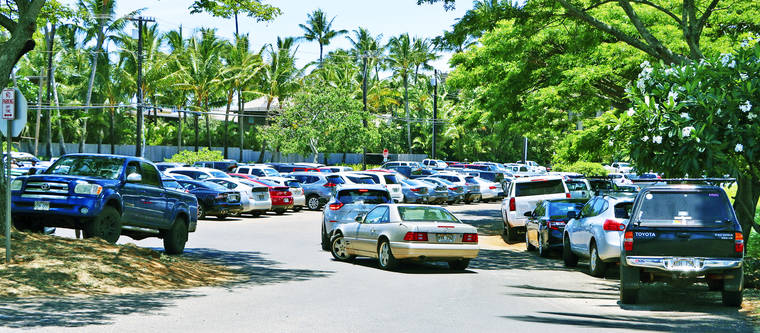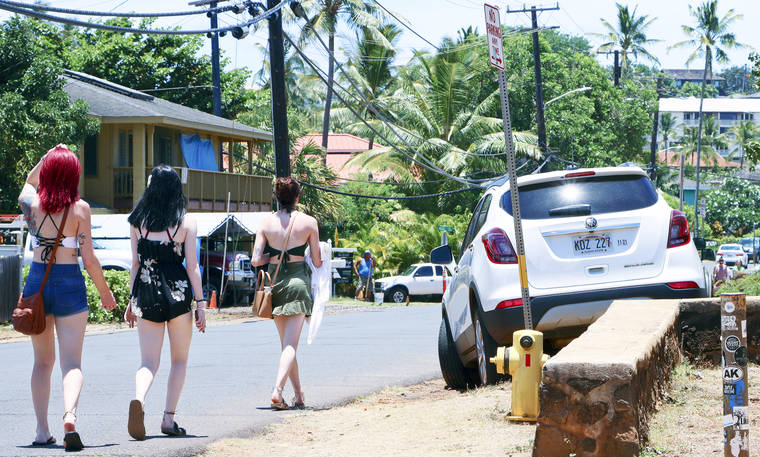LIHU‘E — The county has allocated funding to perform a parking study at Po‘ipu, Lydgate and Hanalei’s Black Pot beach parks.
A $30,000 cut of the county’s American Rescue Plan Act money will go toward this study, to be performed by the Department of Parks &Recreation prior to mitigation and possibly imposing fees on non-resident beach-goers.
“We all know the impacts our parks are facing with the surge of tourism,” Managing Director Michael Dahilig said. “This study will look at ways to better manage the parking situation of tourist vehicles while making it easier for residents to find parking at more-popular destinations.”
Ordinance 1087, formerly Bill No. 2805 that passed through the County Council in December, allows the department to impose parking fees on non-residents, and directs the department to conduct a study to determine those rates. The department will be facilitating the feasibility study, but would need to go back to the council for further approval to enact any such program.
“The study is required by law before we can establish a fee structure at beach parks for visitors,” Councilmember Luke Evslin said. “I think it’s anecdotally clear that some of our beach parks are over capacity, or at least reaching capacity, but we don’t really have clear usage data. This study will help give us a more clear picture.”
Evslin, who introduced the measure with Councilmember Mason Chock, said the bill was in development before the pandemic hit, but it’s clear the issues remain.
“The bill was in development from pre-COVID, and it was developed in response to the clear fact that we are over capacity for tourism,” Evslin said. “As we can see with the rapid return to basically pre-COVID visitor numbers, the pandemic did not change the fundamental fact that we need to better manage our tourism industry.”
Prior to the pandemic, the county was well on its way to setting record-high visitor numbers. When the pandemic did hit, some days fewer than 100 people entered the county. Now, with looser travel restrictions, a bounce in tourism is happening.
On Thursday, June 24, some 32,479 people flew into the state, a little over 2,575 coming into Lihu‘e, according to the Hawai‘i Tourism Authority.
The bill stipulates that any fees derived be added to the Special Trust Fund for Parks and Playgrounds and stay in the “respective district in which such fees were generated.” Violating the parking fees would come with a $100
first-offense fine. Upwards of two offenses would result in a fine of up to $500.
“The county has very few direct mechanisms to capture tourist revenue or reduce the industry’s impact on our infrastructure and natural resources, and parking fees at beach parks can be one of our tools,” Evslin said. “The intent is both to raise revenue for the park and help reduce overall visitor numbers at some of our most-crowded beach parks.”
In the first wave of American Rescue Plan Act money, the county received over $7 million of a total of about $14 million over the next two federal fiscal years.
“The way I see it, American Rescue Plan Act money is to get us back on our feet,” Chock said.
Evslin said that since the county has taken a hit because of the lack of state transient accommodation tax funds, the county needs to continue to look at means of visitor-derived income.
“While most of the ARPA funds will be going out to the community, the proposed study, which is less than half a percent of the first ARPA allocation, is the first step towards helping diversify county revenue collection via parking fees for tourists,” Evslin said.
“This is necessary in the short term to help refill our reserve fund, and necessary in the long run to put us on better fiscal ground while helping reduce impacts on our infrastructure and natural resources,” said Evslin.
•••
Sabrina Bodon, public safety and government reporter, can be reached at 245-0441 or sbodon@thegardenisland.com.








Kauai invited all of these tourists and residents by unzoning property. Our planners simply forgot to add parking and roads for everyone.
Most of these problem beaches are underutilized, it’s just a parking problem.
When you say “crowding,” it seems you’re talking about cars. One way to uncrowd would be to set up a free beach bus system, covering a 5-10 radius around the most popular beaches. Most people arrive from the local area. A smaller percentage travel longer distances.
Since the Lydgate campground closed, the county’s current plan to fill up the parking lots with homeless to discourage tourists from using the park is working just fine. Save the study money to use cleaning up after them when they move back into the campground.
Excellent first step, let’s just make sure we follow through. This fee structure for visitors eventually needs to happen at all beach parks, where parking is once again non existent for residents. And since Ige will veto the new TAT law, our share of the TAT is NEVER COMING BACK (we should be seeing our share of the TAT now that Hawaii is open, where is it?) the County needs to replace that revenue to maintain roads etc from visitor usage. So the fees achieve two goals, reducing usage by visitors and replacing the TAT money that the state seems to ALWAYS take from us. And if the current Council does not act on this issue it is time for different council members next election.
There is a parking fee now. Not going to bother me. I don’t live here. How much to visit Hanalei?
And why are they charging a fee?
Please consider adding in Hoopii Falls. It is a mess. I realize not a park, but access and neighborhood interaction with tourists is becoming heated.
Not that I have a solution, but does anyone really think that putting a ticket on the windshield of a rental car is going to result in a visitor writing a check for a C-note and mailing it in?
The county would probably get choke business if they applied the Barnacle solution like we get in Princeville but that’s a very visible intervention that would probably start getting around on travel related sites that Kauai is a predatory place to visit.
And $30, 000 to “study” what you can look and see in 2 seconds? Hey, I’ll do it for $10K!
Personally, I think no solution is the best solution if there is not the option to create more parking spaces. If you can’t find a space, you can’t find a space, go somewhere else or wait for someone to pull out and leave.
Put up stanchions of some type in areas where fire lanes can’t be blocked and be done with it. As someone who has lived in large cities before, not being able to find a parking place is just a fact of life.
1. Not so sure the fees at Waimea lookouts are really effectively-being collected. There is one attendee and 4 machines at different parking lookouts to take the money and they are not efficient at all. They want to collect user fee but how are you going to collect from the people who are only there to hike and do not use the lookout parking lots?
2. Wailua Falls.. an accident waiting to happen. There are tour guides offering to take people down to the river. Not only dangerous but that is a VERY crowded parking lot most of the time after 10 am. Now these people are parking and going down the sides and leaving their cars for hours, choking the lot!
3. Someone needs to get the word out to visitors that there are fees( most the people I see at Waimea canyon have no clue about fees etc until they are stopped by the attendant as they go up the stairs. The international bloggers(who a lot of young people find) are advertising the Falls, Queen’s Bath, etc but fail to mention you are trespassing or crawling over under a fence with do not do this signs over their heads. The parkinglots should be fixed. The one at Kalalalu lookout is a bearings buster, no to mention the potholes on the way .
4. The lookouts at Opeakaa are so overgrown people stand on the wall to get a picture of the Wailua river.. Why the heck can’t someone, it is a two man job, from the county or state get that done. They trimmed the grass , short grass at that but left the hard stuff for another day?It is another accident waiting to happen that is going to cause the Mayor big headaches and give us bad publicity.
So, fees might need to be collected but what they are doing now is not the way to do it in the future. I’ll leave that to figure out with their 30k study.
Up until April 2021, the visitor arrivals into Hawai’i has been 484,071 tourist. So pretty slow. Maybe 1,000,000 tourist only by year’s end.
I wonder if “non-resident” means “Kauai” non resident, or “Hawaii” non resident.
I also wonder if the “study” will determine the percentage of park users that are really tourists versus residents.
It’s already been 6 months since the ordinance was passed. Now it’ll take another 6 months to do the study. Then it’ll take probably another 6 months to make a decision based on the study.
Maybe “JUST DO IT!” Save the $30,000. Charge $10 per car. After 2 months, see if it’s enough to cover costs. If it isn’t, raise it to $15 per car. It’s called “trial and error”.
Um, without GOOD alternative transport options, imposing parking fees on non-residents will in no way solve the legal and “illegal” parking problems.
It’s time to realize that it’s an infrastructure problem rather than trying to discourage visitors to our beautiful recreational facilities.